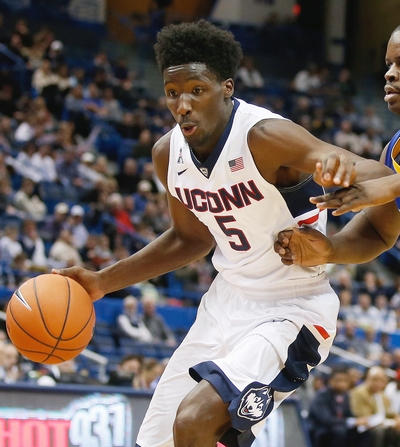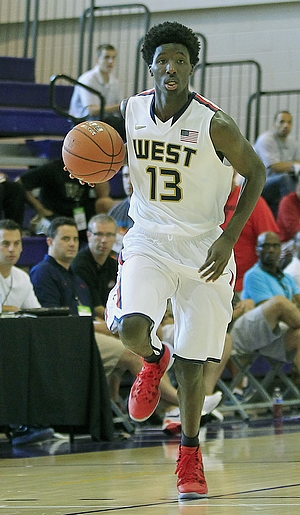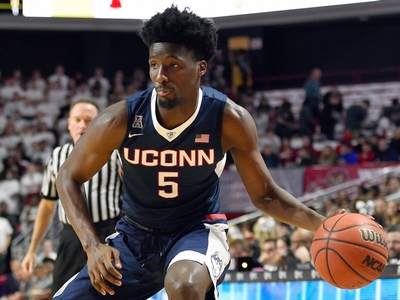Josh Riddell
After missing out on the NCAA Tournament as a freshman, Daniel Hamilton was a key member of a Connecticut team that won its opening round NCAA Tournament game, before falling to top-seeded Kansas in the round of 32. After averaging 12.5 points and 9.0 rebounds per game in his sophomore season, Hamilton elected to enter the NBA Draft and hire an agent very early on in the process, as he had no interest in returning to UConn regardless of his standing, preferring to start his professional career instead.
Hamilton measured 6'6 ¼ barefoot at the NBA Combine, which is excellent for a NBA wing player, especially one with many characteristics of a shooting guard. His wingspan is solid (but not exceptional) at 6'9 as well, but he does not possess a very strong frame at just 197 pounds, and is an average athlete at best on top of that.
His best characteristic is his versatility, as he was one of only three players at the college level to post over five assists per-40 minutes while averaging over 10 rebounds per-40, with the other being potential #1 pick Ben Simmons, and WCC player of the year Kyle Collinsworth.
Although an exceptional passer and rebounder, Hamilton struggled to score efficiently at the college level, posting a true shooting percentage of 49.6%, second lowest among all prospects in our top 100. His shot selection has to be refined with him passing up open 3's for more contested two point shots or taking long two point attempts early in the shot clock. He won't be as big of an offensive focal point at the next level and will likely need to cut down on some of the ill-advised shots that have plagued his game since early in his career.
Hamilton is at his best in the open court, where his excellent feel for the game really shines through. In half-court situations, he is a little more limited, as he doesn't always have the fancy ball-handling or overwhelming first step required to get past his man in isolation and get all the way to the rim. He can get sped up and out of control at times, being unable to find the seams in the defense and driving into brick walls. He'll bog down the offense at times by pounding the ball while looking for an opening to make his move, and when he does look to probe the defense, he has to settle for an off balance floater or contested mid-range shot.
Hamilton's biggest issue at the college level was his struggles scoring around the basket at a high rate, converting only 41.6% of his overall two point shots and 42.7% of his attempts around the rim according to Synergy Sports Technology. While his ability to handle the ball and pass at his size is extremely intriguing, it's hard to project him as someone who will have the offense running through him due to his extreme inefficiencies inside the arc, unless he's able to improve his frame or find a way to cut down on his turnovers.
Hamilton's court vision at 6'8 may make him a project worth developing for a NBA team, and undoubtedly gives him a future in professional basketball. His 6.0 assists per 40 minutes pace adjusted is an outstanding mark for a shooting guard, and could certainly be refined into an asset if he can round out some of the rougher edges in his game.
That will include becoming a more consistent perimeter threat. Hamilton finished his collegiate career as a 33.7% shooter on three point attempts, struggling off both catch and shoot and off the dribble shots. Some of this has to do with his role, as Hamilton was at times forced to carry too big of an offensive load. He actually moves well without the ball and has a pretty good stroke that demonstrate some potential as an outside shooter, but he will need to show that his low percentages were more a result of his shot selection than his ability to actually make shots during the workout process. If Hamilton can find a way to refine his stroke and become a more efficient 3-point shooter, he'll have a much easier time demonstrating to teams he has a clear-cut role at the NBA level.
Hamilton is an elite defensive rebounder for a player of any size but especially for a predominantly wing player, as his 10.3 defensive rebounds per 40 minutes ranks sixth among all prospects in our top 100 and is one of the best historical marks for players of his size. If he is drafted, he will join a club made up of Kenneth Faried, Luke Harangody, Arslan Kazemi, Andre Roberson and Draymond Green as the only other players since 2000 who were 6'8 or shorter to post similar rebounding numbers in a single collegiate season before going on to be drafted.
Hamilton attacks the glass with fervor, intensely chasing down loose balls and pushing the ball in transition after he secures the rebound. He loves to rebound defensively and goes after every miss coming off the rim, even those outside his area. This is a reflection of not only his intensity level, but also his tremendous anticipation skills and overall feel for the game, as he pursues loose balls with exceptional timing and instincts.
The rest of his defensive contributions lag behind, though, and he will need to improve his focus and discipline to guard at the NBA level. While his height and ability to move laterally gives him some potential, his average length, strength and footwork is holding him back from being a versatile defender. He is often standing straight up, even on the ball, which limits his ability to react to plays around him. He looks disinterested on defense until a shot goes up and he can compete for a rebound, but he will need to provide more value than that at the NBA level.
A very unique prospect in terms of the extreme contrasts between his strengths and weaknesses, Hamilton has some very interesting characteristics that could be refined into an impressive overall profile if he can find a way to become a more consistent perimeter shooter and defender. It's very possible a team could fall in love with him based on this potential production and give him a shot to make a roster, either through the draft or training camp. Even if he doesn't make it on his first go-around, Hamilton is someone teams will continue to monitor at the pro level to see how his shooting, decision making and defense is evolving.
Articles
Underclassmen Who May Need To Return After Middling Combine Showings
May 15, 2016, 11:30 am
The only player on this list that has actually hired an agent, Daniel Hamilton struggled to do anything positive for most of the NBA Combine, which almost certainly seals his fate to go undrafted considering where he started off. Hamilton was a triple-double threat at the college level whose poor frame and athleticism was always likely going to be a hindrance to creating efficient offense at the pro level. Those fears were realized in a serious way in Chicago, as he struggled to get past anyone, forced up bad looks from all over the floor, and didn't make up for that with his perimeter shooting or defensive prowess. Hamilton will have some options in mid-level Europe starting this summer already, as there aren't many players his size with that type of versatility, but that might not have been the original plan when he decided to leave school for good very early on in the process. A year in the D-League could be an option as well. It's possible that he simply wasn't a fan of being a college student and prefers to pursue developing elsewhere, but the statements he made when he declared suggest otherwise: "I'm hearing first round, maybe second round," Hamilton said. "Wherever I get drafted, I'll be OK with it.
NCAA Tournament NBA Draft Prospect TV Schedule: Thursday
Mar 16, 2016, 11:18 am
Daniel Hamilton came into the season ranked as a lottery pick by some outlets (never this one) but has struggled to show much progress physically and skill-wise. He'll have to be a much more reliable perimeter shooter and try to dial back on some of the wild decisions he tends to make, particularly in transition, to take the next step in his development. His rebounding ability from the wing position, as well as his elite court vision will always keep scouts intrigued, but he'll have to figure out how to mitigate his lackluster frame and explosiveness as a finisher around the basket, where he's consistently struggled throughout his career.
Top NBA Draft Prospects in the AAC, Part One: Prospects #1-5
Oct 05, 2015, 06:27 pm
Jonathan Givony
One of four brothers to play Division I basketball, including a former NBA first round pick (Jordan, currently playing in Russia), Daniel Hamilton had a fairly successful freshman season for UConn, winning AAC Rookie of the Year honors.
Still, on a team level, it was somewhat of a disappointing year, as the defending NCAA champions lost in the first round of the NIT, despite starting the season ranked in everyone's preseason Top-20.

Hamilton started every game for the Huskies and ranked second in usage rate behind now-departed Ryan Boatright. He played a variety of roles in Kevin Ollie's offense, sliding between the wing and the power forward spot, doing a significant amount of ball-handling and playmaking, and gaining significant experience in advance of what is likely to be a telling season for the former #17 ranked high school recruit.
Hamilton has excellent size for the wing at 6-8, but does not possess a very strong frame, has a poor wingspan measured at just 6-8, and is just an average athlete overall. He's added 20 pounds to his frame since the first measurement we have on him from the summer of 2013, weighing in at a still lanky 198 pounds at the Nike Academy this past June.
Hamilton's best attribute as a pro prospect revolves around his ability to handle the basketball and make plays for both himself and others at his size. Including passes, just under 40% of his offense came in pick and roll, isolation or transition situations according to Synergy Sports Technology, which is a significant number for a freshman wing player. He can grab a rebound and take the ball coast to coast, is capable of taking opponents off the dribble in the half-court, and is a terrific passer as evidenced by the 4.9 assist per-40 minutes he averaged last season.
Hamilton has a knack for finding the open man, showing really nice instincts moving the ball ahead in transition, feeding his big men with lobs, driving and dishing, or simply making the extra pass along the perimeter. His ability to facilitate and fuel his team's ball-movement is one of his most intriguing aspects as a draft prospect and something that leaves room for optimism regarding his future development.
Hamilton also showed some potential as a shooter last season, both off the dribble and with his feet set, making 34% of his 3-point attempts. Right now he's more of a shot-maker than anything, as he was wildly inconsistent with his jumper over the course of the season, being absolutely on fire in some games, and ice cold in others.
Poor shot-selection played a major role in Hamilton's inconsistency as a freshman, but he also has room to improve his mechanics, particularly from the waist down, where he can be sloppy at times with his footwork and tends to contort his body sideways unnecessarily. Becoming a more consistent threat from beyond the arc will be very important in Hamilton's development as a pro prospect.
Inside the arc, Hamilton is very much a mixed bag at the moment, as evidenced by his very poor 40% 2-point percentage, and significant struggles getting to the free throw line (3.2 per-40) despite the amount of ball-handling he does. This played a major part in his paltry 47% true shooting percentage, which is the fourth worst mark among collegiate DX Top-100 prospects.
Hamilton's issues here are two-fold. For one, he takes quite a few off the dribble jumpers in the mid-range area, about 2.5 per game, and only hits 34% of them (.709 PPP), which is not a very attractive proposition.
Secondly, he is a very poor finisher when he does venture closer to the basket, hitting just 46% of his inside the paint attempts last season. Hamilton is one of only handful of players in college basketball to attempt more floaters than lay-ups in the half-court according to Synergy Sports Technology, which tells you something about his struggles getting all the way to the basket. His combination of an average first step, a significant lack of upper and lower body strength, and poor explosiveness make it very difficult for him to convert plays in traffic at a high rate, and help explain why he gets to the free throw line so infrequently.
Hamilton's struggles also translate to the open court, where his raw decision making skills are reflected in his gigantic 30% turnover rate and overall mediocre 0.7 points per possession in transition, one of the lowest rates in all of college basketball.
Defensively, Hamilton was similarly inconsistent last season. On one hand his combination of size, anticipation skills and instincts give him a very nice framework to build off, which would translate to some very impressive possessions from time to time when he was fully engaged. He already ranked as one of the best defensive rebounders in the country among wing players (8.8 per-40), and got in the passing lanes at a fairly nice rate (1.3 steals per-40) as well.
On the other hand, Hamilton's narrow frame, poor length and inconsistent effort level made him somewhat of a target at times for opposing coaching staffs to pick at, particularly when he was tasked with guarding power forwards in the post. He tends to ball-watch and fall asleep in his stance off the ball, displays lackluster urgency fighting through screens and contesting shots on the perimeter, and gambles wildly for steals too frequently.
Very highly regarded by the recruiting services coming out of high school, and considered a lottery pick even now by the likes of analysts such as Jeff Goodman and others going into this season, Daniel Hamilton undoubtedly has his fans in certain circles. His freshman year was somewhat of a roller coaster ride, but there's no questioning the fact that he shows talent as a 6-8 playmaker and shot-maker, which will make him a very interesting prospect to follow as a sophomore.
One of four brothers to play Division I basketball, including a former NBA first round pick (Jordan, currently playing in Russia), Daniel Hamilton had a fairly successful freshman season for UConn, winning AAC Rookie of the Year honors.
Still, on a team level, it was somewhat of a disappointing year, as the defending NCAA champions lost in the first round of the NIT, despite starting the season ranked in everyone's preseason Top-20.

Hamilton started every game for the Huskies and ranked second in usage rate behind now-departed Ryan Boatright. He played a variety of roles in Kevin Ollie's offense, sliding between the wing and the power forward spot, doing a significant amount of ball-handling and playmaking, and gaining significant experience in advance of what is likely to be a telling season for the former #17 ranked high school recruit.
Hamilton has excellent size for the wing at 6-8, but does not possess a very strong frame, has a poor wingspan measured at just 6-8, and is just an average athlete overall. He's added 20 pounds to his frame since the first measurement we have on him from the summer of 2013, weighing in at a still lanky 198 pounds at the Nike Academy this past June.
Hamilton's best attribute as a pro prospect revolves around his ability to handle the basketball and make plays for both himself and others at his size. Including passes, just under 40% of his offense came in pick and roll, isolation or transition situations according to Synergy Sports Technology, which is a significant number for a freshman wing player. He can grab a rebound and take the ball coast to coast, is capable of taking opponents off the dribble in the half-court, and is a terrific passer as evidenced by the 4.9 assist per-40 minutes he averaged last season.
Hamilton has a knack for finding the open man, showing really nice instincts moving the ball ahead in transition, feeding his big men with lobs, driving and dishing, or simply making the extra pass along the perimeter. His ability to facilitate and fuel his team's ball-movement is one of his most intriguing aspects as a draft prospect and something that leaves room for optimism regarding his future development.
Hamilton also showed some potential as a shooter last season, both off the dribble and with his feet set, making 34% of his 3-point attempts. Right now he's more of a shot-maker than anything, as he was wildly inconsistent with his jumper over the course of the season, being absolutely on fire in some games, and ice cold in others.
Poor shot-selection played a major role in Hamilton's inconsistency as a freshman, but he also has room to improve his mechanics, particularly from the waist down, where he can be sloppy at times with his footwork and tends to contort his body sideways unnecessarily. Becoming a more consistent threat from beyond the arc will be very important in Hamilton's development as a pro prospect.
Inside the arc, Hamilton is very much a mixed bag at the moment, as evidenced by his very poor 40% 2-point percentage, and significant struggles getting to the free throw line (3.2 per-40) despite the amount of ball-handling he does. This played a major part in his paltry 47% true shooting percentage, which is the fourth worst mark among collegiate DX Top-100 prospects.
Hamilton's issues here are two-fold. For one, he takes quite a few off the dribble jumpers in the mid-range area, about 2.5 per game, and only hits 34% of them (.709 PPP), which is not a very attractive proposition.
Secondly, he is a very poor finisher when he does venture closer to the basket, hitting just 46% of his inside the paint attempts last season. Hamilton is one of only handful of players in college basketball to attempt more floaters than lay-ups in the half-court according to Synergy Sports Technology, which tells you something about his struggles getting all the way to the basket. His combination of an average first step, a significant lack of upper and lower body strength, and poor explosiveness make it very difficult for him to convert plays in traffic at a high rate, and help explain why he gets to the free throw line so infrequently.
Hamilton's struggles also translate to the open court, where his raw decision making skills are reflected in his gigantic 30% turnover rate and overall mediocre 0.7 points per possession in transition, one of the lowest rates in all of college basketball.
Defensively, Hamilton was similarly inconsistent last season. On one hand his combination of size, anticipation skills and instincts give him a very nice framework to build off, which would translate to some very impressive possessions from time to time when he was fully engaged. He already ranked as one of the best defensive rebounders in the country among wing players (8.8 per-40), and got in the passing lanes at a fairly nice rate (1.3 steals per-40) as well.
On the other hand, Hamilton's narrow frame, poor length and inconsistent effort level made him somewhat of a target at times for opposing coaching staffs to pick at, particularly when he was tasked with guarding power forwards in the post. He tends to ball-watch and fall asleep in his stance off the ball, displays lackluster urgency fighting through screens and contesting shots on the perimeter, and gambles wildly for steals too frequently.
Very highly regarded by the recruiting services coming out of high school, and considered a lottery pick even now by the likes of analysts such as Jeff Goodman and others going into this season, Daniel Hamilton undoubtedly has his fans in certain circles. His freshman year was somewhat of a roller coaster ride, but there's no questioning the fact that he shows talent as a 6-8 playmaker and shot-maker, which will make him a very interesting prospect to follow as a sophomore.
High School Class of 2014 Scouting Reports, Part Three- the Wings
Sep 05, 2013, 03:06 pm

Jonathan Givony
Recruiting Rankings: 247: #11, ESPN: #17, Scout: #15, Rivals: #15
Committed to Connecticut
Strengths:
-Excellent size for a wing at 6-8 ½
-Very good scoring instincts
-Outstanding perimeter shooter
-Can create separation and make tough shots off the dribble. Has a knack for throwing the ball in the basket
-Good footwork. Uses shot-fakes to open up driving angles
-Good in transition
-Can pass the ball when he wants to. Has a solid feel for the game
Weaknesses:
-Narrow frame
-Average wingspan
-First step is underwhelming. Not overly explosive in the half-court
-Struggles to finish around the basket at times
-Plays for himself. Looks very wild/selfish at times. Rarely passes the ball
-Body language is poor
-Doesn't show any interest in playing defense
Outlook: Extremely talented scorer at the high school level. Has many of the same strengths and weaknesses as his brother Jordan (Denver Nuggets), but doesn't have as good of a frame. Did not appear to be a very team oriented player in any of the settings we observed him in.




























Comments